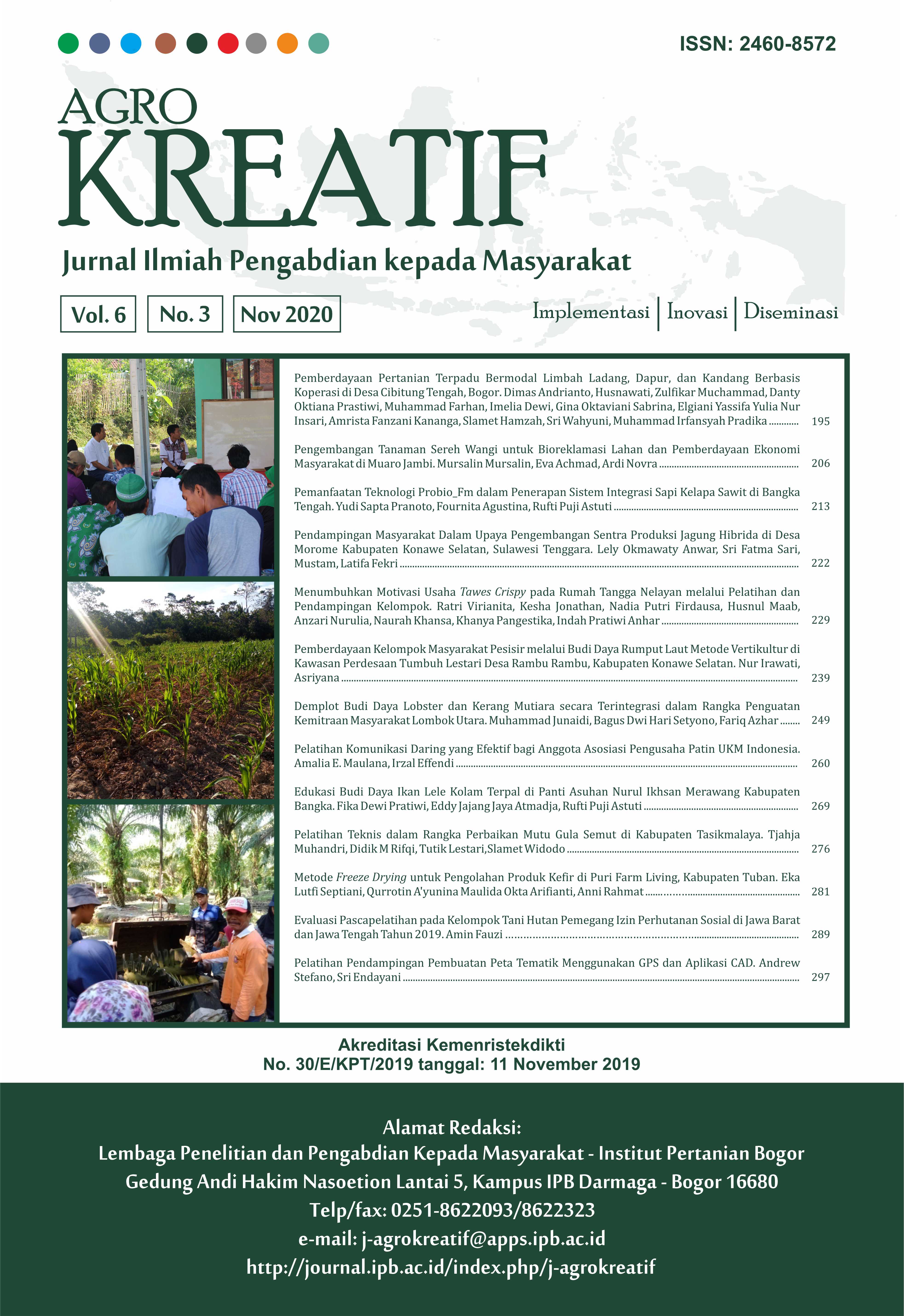Metode Freeze Drying untuk Pengolahan Produk Kefir di Puri Farm Living, Kabupaten Tuban
Abstract
Kefir is a food made from fermented milk of cows or goats which are believed to have many benefits including as a source of probiotics, maintaining bone health, and reducing cholesterol. Puri Farm Living is a kefir-producing business unit located in Tuban District which often faced the problem of declining of kefir liquid quality during the shipping process. Kefir liquid suffered damage caused by bacterial growth activities which can continuously press the container. Thus, the container is not able to accommodate it. In addition, kefir products have a fairly short expiration period if they are exposed in ambient temperature for more than 6 hours. Freeze drying is a method of drying food products at low temperatures to maintain the function of bacteria in kefir. The community service program aims to provide the partner member skills in operating the freeze drying device. The stages of the program includes: 1) problem survey and needs analysis, 2) design of freeze drying equipment, 3) testing and installation, 4) training, 5) monitoring and evaluation. The results indicate that partners are able to use the freeze drying device, both in the process of preparing raw materials, production, and packaging. In addition, the partner has succeeded to produce 150 capsules containing dried kefir that have not been damaged after more than 6 hours. Moreover, there are business units from other regions that highly want to apply this method in kefir processing. Therefore, this method has been considered quite effective to overcome the problem of distributing kefir products.
Downloads
References
Aisha EZ, Zubaidah E, Ningtyas DW. 2003. Pembuatan Kefir Bubuk dengan Metode Foam-Mat Drying (Kajian Proporsi Buih Putih Telur dan Konsentrasi Dekstrin. Malang (ID): Universitas Brawijaya.
Angulo L, Lopez E, Lema C. 1993. Microflora present in kefir grains of the Galician region (North-West of Spain ). Journal of Dairy Research. 6(2): 263–267. https://doi.org/10.1017/S002202990002759X
Bezie A. 2019. The Effect of Different Heat Treatment on the Nutritional Value of Milk and Milk Products and Shelf-Life of Milk Products. A Review. Journal of Dairy and Veterinary Sciences. 11(5): 1‒8. https://doi.org/10.19080/JDVS.2019.11.555822
Bolla PA, Serradell MDLA, Urraza PJD, Antoni GLD. 2011. Effect of freeze-drying on viability and in vitro probiotic properties of a mixture of lactic acid bacteria and yeasts isolated from kefir. The Journal of Dairy Research. 78(1): 15‒22. https://doi.org/10.1017/S0022029910000610
Cahyati DNM, Putri BRT, Sukanata IW. 2015. Strategi Pemasaran "Kefir" sebagai upaya diversifikasi produk Olahan Susu Fermentasi. Peternakan Tropika. 3(3): 609–620.
Ciurzyńska A, Lenart A. 2011. Freeze-Drying-Application in Food Processing and Biotechnology. Polish Journal of Food and Nutrition Sciences. 61(3): 165–171. https://doi.org/10.2478/v10222-011-0017-5
Conde-Islas AÁ, Jim M, Cant D, Rafael G, Luna-solano G. 2019. Effect of the Freeze-Drying Process on the Physicochemical and Microbiological Properties of Mexican Kefir Grains. Processes. 7(3): 127‒142. https://doi.org/10.3390/pr7030127
Geankoplis CJ. 2003. Transport processes and separation process principles:(includes unit operations). New Jersey (US): Prentice Hall Professional Technical Reference.
Hariyadi P. 2013. Freeze Drying: for Better Quality & Flavor of Dried Products. Foodreview Indonesia. 8(2): 52‒57.
Hadrianti HDL, Safaruddin, Ka’bah. 2019. Pengolahan Dan Pemasaran Online Produk Susu Kefir Di Desa Gunung Perak Kabupaten Sinjai. Celebes Abdimas: Jurnal Pengabdian Kepada Masyarakat. 1(2): 101‒109. https://doi.org/10.37541/celebesabdimas.v1i2.223
Jensen CM, Lee DW. 2000. Cost-Effective Teacher Dry-Ice Bath Based on Ethylene Glycol Mixtures. Journal of Chemical Education. 77(5): 629‒630. https://doi.org/10.1021/ed077p629
Katafiasz AR, Bartlett P. 2012. Motivation for unpasteurized milk consumption in Michigan, 2011. Food Protection Trends. 32(3): 124‒128.
Lindawati SA, Sriyani NLP, Hartawan M, Suranjaya IG. 2015. Study mikrobiologis kefir dengan waktu simpan berbeda. Majalah Ilmiah Peternakan. 18(3): 95‒99. https://doi.org/10.24843/MIP.2015.v18.i03.p03
Moeljanto RD. 2002. Khasiat & manfaat susu kambing: susu terbaik dari hewan Ruminansia. Jakarta (ID): AgroMedia.
Papavasiliou G, Kourkoutas Y, Rapti A, Sipsas V, Soupioni M, Koutinas AA. 2008. Production of freeze-dried kefir culture using whey. International Dairy Journal. 18(3): 247–254. https://doi.org/10.1016/j.idairyj.2007.09.005
Park YW. 2017. Goat milk–chemistry and nutrition. In: Handbook of milk of non‐bovine mammals. Page: 42‒83. New York (US): Wiley Online Library. https://doi.org/10.1002/9781119110316.ch2.2
Rosa DD, Dias MMS, Grześkowiak ŁM, Reis SA, Conceição LL, Peluzio MCG. 2017. Milk kefir : nutritional, microbiological and health benefits. Nutrition Research Reviews. 30(1): 82‒96. https://doi.org/10.1017/S0954422416000275
Santivarangkna C, Kulozik U, Foerst P. 2008. Inactivation mechanisms of lactic acid starter cultures preserved by drying processes. Journal of Applied Microbiology .105(1): 1–13. https://doi.org/10.1111/j.1365-2672.2008.03744.x
Sukarno, Surya A, Nurliyani, Indratiningsih. 2014. Powdered Yoghurt Probiotic Quality Produced by Foam-Mat Drying Method with different Drying Temperature and Albumen Level. In: The 16th AAAP Congress: Sustainable Livestock Production in the Perspective of Food Security, Policy, Genetic Resources, and Climate Change. Yogyakarta (ID).
Susilawati, Zulferiyenni, Sari PA, Sartika D. 2017. Penyuluhan Dan Pelatihan Pembuatan Kefir Susu Kambing Dalam Rangka Meningkatkan Gizi Masyarakat Di Desa Sumber Rejo Kecamatan Jati Agung Kabupaten Lampung Selatan. Sakai Sambayan Jurnal Pengabdian kepada Masyarakat. 1(3): 140‒144.
Widodo. 2003. Bioteknologi Industri Susu. Cetakan Ke-1. Yogyakarta (ID): Lacticia Press.
Woods PS, Pollister AW. 1955. An ice-solvent method of drying frozen tissue for plant cytology. Stain technology. 30(3): 123‒131. https://doi.org/10.3109/10520295509113755drying processes. Journal of Applied Microbiology .105(1): 1–13. https://doi.org/10.1111/j.1365-2672.2008.03744.x
Sukarno, Surya A, Nurliyani, Indratiningsih. 2014. Powdered Yoghurt Probiotic Quality Produced by Foam-Mat Drying Method with different Drying Temperature and Albumen Level. In: The 16th AAAP Congress: Sustainable Livestock Production in the Perspective of Food Security, Policy, Genetic Resources, and Climate Change. Yogyakarta (ID).
Susilawati, Zulferiyenni, Sari PA, Sartika D. 2017. Penyuluhan Dan Pelatihan Pembuatan Kefir Susu Kambing Dalam Rangka Meningkatkan Gizi Masyarakat Di Desa Sumber Rejo Kecamatan Jati Agung Kabupaten Lampung Selatan. Sakai Sambayan Jurnal Pengabdian kepada Masyarakat. 1(3): 140‒144.
Woods PS, Pollister AW. 1955. An ice-solvent method of drying frozen tissue for plant cytology. Stain technology. 30(3): 123‒131. https://doi.org/10.3109/10520295509113755
This work is licensed under a Creative Commons Attribution-NonCommercial 4.0 International License.



















